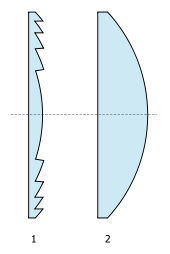Polylux (device)
The overhead projector is an original in the GDR produced overhead projector . Polylux was a generic name for daylight projectors in the GDR .
history
The Polylux was manufactured in the GDR since 1969 by the state-owned company VEB Phylatex-Physikgerätewerk GDR in Frankenberg near Chemnitz (then Karl-Marx-Stadt). It was widespread among other things at the educational institutions of the GDR . From 2004, Polylux was a registered trademark of Polytechnik Frankenberg GmbH , which built and sold the device as the successor to the original Polylux manufacturer. Up to the turn of 1989, an average of 27,000 devices were built per year, which were also exported to the Soviet Union . In 2004 there were still 6,000 units built per year.
In 2006 the company was closed.
The word Polylux (from Greek and Latin : “lots of light”) was invented by Erich Schöpe , a graduate physicist and former head of development at the Polylux manufacturer. Today it has cult status as a typical GDR word and is still widespread in current linguistic usage in East Germany.
Originally the device lenses of the Polylux were made of glass. Lenses made of plastic were later used to reduce weight . In particular, the large-area Fresnel lens was made of plastic . The film overlay was made of glass.
Polylux 1
The housing of the Polylux 1 was made of plastic and contained a fan with temperature-dependent overrun (bimetal switch) to prevent heat build-up . The light source was a halogen - bulb for line voltage with an output of 650 watts . This could be operated via series resistors in economy circuit for a longer service life with slightly reduced light output. The first models had a rotary switch for this purpose, while later two separate toggle switches were used. The rotary switch offered the advantage that the economy circuit and thus the resistors were automatically switched on, which was beneficial by limiting the high inrush current of the lamp.
Polylux 1 with a thematic map of Latin America in the GDR Museum Pirna
The Polylux 1 on a postage stamp for the Leipzig trade fair in 1972
Polylux 2
The Polylux 2 model was slightly larger and heavier, as it now contained a transformer for the 24 V light throw lamp with an output of 250 W. The electrical controls consisted of two rocker switches, one serving as a power switch and the other for switching between economy mode and full light output. The latter was indicated by a red indicator light. The axial fan driven by a shaded-pole motor has moved from the rear to the side and no longer had any overrun when the device was switched off. Instead, the device contained a bimetal switch, which switched off the lamp if it overheated. The Polylux 2 did not have a lamp changer that is common today so that it could switch directly to the replacement lamp in the event of failure of the light projection lamp. There was also a safety switch that prevented start-up when the top cover was open, so that there was no contact with live or hot parts or the risk of accidents on the running fan, since the necessary cooling of the lamp or lamp housing was not given when the cover was open and the person carrying out the work would have been dazzled anyway with the lamp on.
Television broadcast
The program Polylux , produced by the ORB and later by the RBB , was named after the Polylux in reference to the “illuminating” function of the device.
Web links
- Robotrontechnik.de Illustration of the Polylux and information about the company




